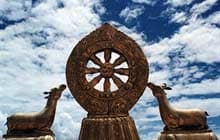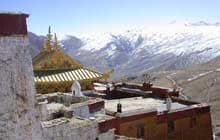The Jokhang, or "House of the Lord," is the holiest site in Tibet and is the ultimate pilgrimage destination for Tibetan Buddhists. King Songtsen Gampo first built a temple here in the mid-7th century, but the structure that we see today is largely the result of reconstruction in the 17th century, commissioned by the Fifth Dalai Lama. The Jokhang houses the Jowo Buddha, a Buddhist sculpture brought as part of the dowry of the Chinese Princess Wencheng upon her arrival in Tibet. » Read more »
» Read more »Prophesied by the historic Buddha approximately about 2,000 years before his birth, Tsongkhapa (1357-1419) was a child prodigy who went on to establish and inspire Tibet's most powerful monastic sect. Dissatisfied by the ill discipline – intellectual, religious and monastic – of contemporary orders, he reined his disciples and followers into a strict new order. The Gelug sect re-established the austerity of monastic life and emphasized the primacy of philosophical study within it. Ganden Monastery was founded near » Read more »
» Read more »Jamyang Choje, a disciple of Tsongkhapa, founded Drepung Monastery in 1416. He is reputed to have been born to a wealthy family near the town of Samye and to have secured initial finances for the construction of the monastery from a wealthy childhood friend. Likewise, the immediate popularity of the monastery, which had some 2000 monks in residence within the first two years, is attributed to the support of wealthy family friends.
At its height, » Read more »
» Read more »Lingyin Temple, or the Temple of Inspired Seclusion, was founded in 326 AD by the Indian monk, Hui Li. It quickly became a center of worship for the Chan (Zen) Buddist sect, and once served as home to more than three thousand monks. During its turbulent history the temple has been destroyed and then restored no less than sixteen times with the current structures dating to the late Qing dynasty (1644-1911).
Before reaching the temple however, » Read more »
» Read more »
These are the bare facts: the Mogao cave complex is comprised of 492 caves, containing 450,000 square feet of murals dating from the fourth to the fourteenth centuries – a period which corresponds to an immense growth in international commerce along the nearby Silk Road. The caves were abandoned in the fourteenth century and lay untouched until the beginning of the twentieth century.
These facts presume ten centuries of consecutive public works programs of astonishing financial proportions and startling logistical complications. » Read more »
» Read more »



